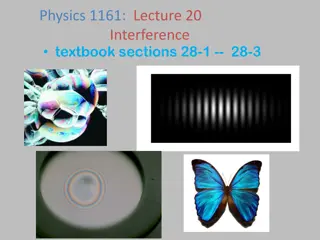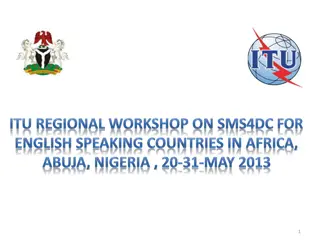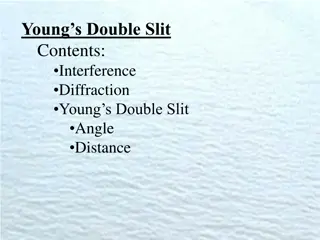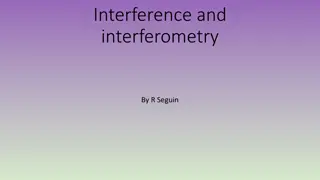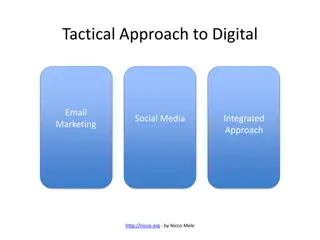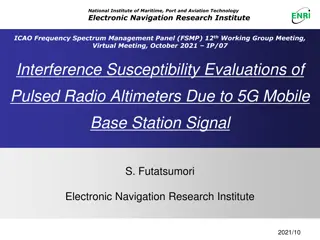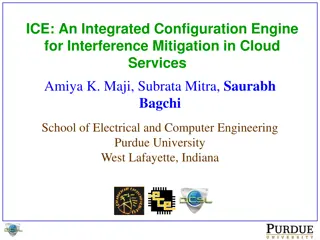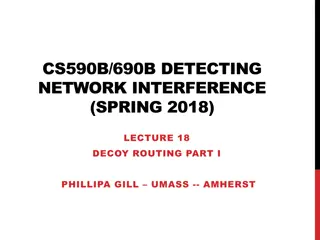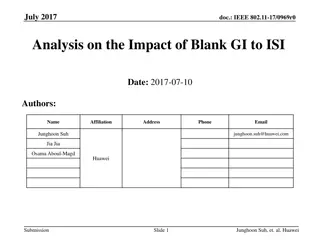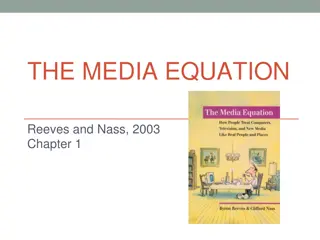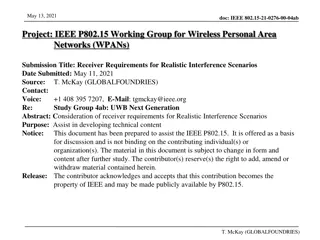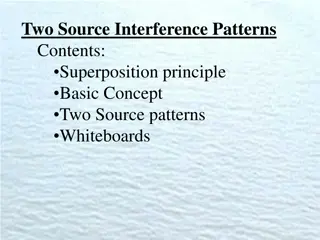Understanding Network Interference and Censorship in Social Media
Discover the insights into detecting network interference, censorship, and social media manipulation through a collection of case studies, research papers, and real-world examples discussed in a Spring 2018 lecture. Topics include the goals of PAM 2011 paper, the Green Dam and Blue Dam projects, the role of the Great Cannon, Concept Doppler's techniques, and the impact of censorship on online social networks. Learn about the challenges and limitations of Concept Doppler, the localization of censors in China, and how social media platforms can influence online content. Dive into the complexities of political censorship using Twitter spam and explore effective ways to study government takedown requests in online spaces.
Download Presentation

Please find below an Image/Link to download the presentation.
The content on the website is provided AS IS for your information and personal use only. It may not be sold, licensed, or shared on other websites without obtaining consent from the author. Download presentation by click this link. If you encounter any issues during the download, it is possible that the publisher has removed the file from their server.
E N D
Presentation Transcript
CS590B/690B DETECTING NETWORK INTERFERENCE (SPRING 2018) LECTURE 11
WHERE WE ARE Social nets for flu tracking: https://www.washingtonpost.com/news/to-your- health/wp/2014/03/19/a-better-flu-tracker-using-twitter-not- google/?utm_term=.60820416353b Last time: Case studies: China + Iran Midterm A2 was due last night A3 due Friday (trace analysis with Wireshark + Q&A) Questions?
TEST YOUR KNOWLEDGE 1. What was the goal of the PAM 2011 paper? 2. What was a necessary first step that paper had to take? 3. How did they go about this? 4. Where did they find censors located? 5. Why would censors be distributed across the provinces? 6. Describe the Great Cannon and how it operates
TEST YOUR KNOWLEDGE 1. What were the Green Dam and Blue Dam projects? 2. How did Concept Doppler test for blocking by the GFW? 3. How did Concept Doppler localize the Chinese censor? 4. How does LSA help Concept Doppler? 5. What are challenges/limitations of Concept Doppler? 6. What was the goal of the second reading? 7. What was a necessary first step that paper had to take? 8. How did they go about this? 9. Where did they find censors located? 10. Why would censors be distributed across the provinces?
TODAY Censorship + Social Media Twitter spam for political censorship http://www.icir.org/vern/papers/kremlin-bots.leet11.pdf http://0b4af6cdc2f0c5998459- c0245c5c937c5dedcca3f1764ecc9b2f.r43.cf2.rackcdn.com/123 85-foci13-verkamp.pdf Censorship on Weibo http://xxx.tau.ac.il/pdf/1303.0597v1.pdf http://www.ccs.neu.edu/home/cbw/pdf/weibo-cosn13.pdf
OSN CENSORSHIP OSN = online social network Layer 8 censorship Control the social network, perform in house filtering E.g., China: Weibo, Renren, etc. Get social network to cooperate with take down requests E.g., twitter https://rsf.org/en/news/dictators-can-thank-twitter-its-new- censorship-policy Social network itself can influence what is shown E.g., https://www.forbes.com/sites/kalevleetaru/2018/01/12/is- twitter-really-censoring-free-speech/#1e19e02165f5 Filter bubble Spam + drown out conversation E.g., today s reading Astroturfing
ASIDE: HOW TO STUDY TAKE DOWNS? Groups working to track government take down requests Transparency reports of companies https://lumendatabase.org Try to get content taken down + measure speed etc. We tried this could not get content taken down :P
RELATED READING 1 Adapting Social Spam Infrastructure for Political Censorship. Relevant concepts: Diluting hashtag content: injecting bogus messages containing the given hashtag to drown out legitimate messages Social network abuse detection: Many strategies for identifying sybil accounts in online social networks (e.g., social graph, distribution of posts, properties of the account). This paper relies on Twitter s internal spam detector: based on frequent formation of relationships, posting duplicate content, posting to multiple hashtags, misleading content to trending topics. Spam-as-a-Service: marketplaces where parties can sell and trade resources (eg., e-mail addresses, fraudulent accounts, proxies, compromised hosts, etc.)
IDENTIFYING AUTOMATED ACCOUNTS Identify all accounts that post a tweet containing # between Dec. 5-6, 2011 This tag was previously reported to be a target of spam To identify additional hashtags: Look at hashtags posted by this set of users during the Dec 5-6 time window with at least 1,500 participants. In total 20 hashtags posted by 46k accounts
IDENTIFYING AUTOMATED ACCOUNTS Of the 46K accounts tweeting these 20 hashtags, 24K had been suspended by Twitter s spam detection algorithm 1.6K additional accounts are included since they include similar looking e-mails and were created at the same time as many of the spam accounts Analysis of the incident in three components: Tweets before/during the incident Account creation IP addresses used to access Twitter
TWEETS 440K tweets targeting the 20 hashtags Up to 1.8K tweets per minute Spam accounts were active for many fewer days. Sporadic periods of activity starting in May 2011.
ACCOUNTS Bot accounts tended to have mail.ru e-mail addresses (99.5%) Four types of account names used. These heuristics/reg-exes allow them to identify nearly 1M more spam accounts 80% of which haven t been identified by Twitter algorithm yet.
IMPACT Relevant vs. realtime search results makes a difference Relevance based searches return 53% fewer spam tweets Taking 5 most recent relevant tweets results in 64% fewer spam tweets. Social graph + interests can help search mitigate message dilution attacks.
OTHER INCIDENTS Five incidents, one theme.
READING 2: SOCIAL MEDIA CENSORSHIP IN CHINA Western online social networks (OSNs) blocked local alternatives provided These local alternatives provide censors with a tighter rein on the content that is posted since these products are in their jurisdiction
WEIBO IS A POPULAR SUBJECT FOR RESEARCH Velocity of censorship Identifying sensitive users Users who post about 25 previously-banned keywords Anyone these users retweet at least 5 times was potentially sensitive Monitored these users until they had 5 posts remove then added them to the set of ``sensitive users. 15 days of this process: 3.5K users 4.5K post deletions per day for these users ~12% of posts from sensitive users deleted ~1 minute granularity on monitoring these users Weibo accounts + 300 Tor circuits needed to accomplish this
TYPES OF DELETIONS general deletion when a query for a post results in post does not exist permission-denied deletion / system deletion when the query results in a permission denied error code Relation of posts: if A is a repost of B; A is the Child post and B is the parent post 82% of deletions are of child posts; 75% have pictures either in the child or parent post. Deletions happen fast: 30% within 30 minutes, 90% within a day.
FACTORS THAT IMPACT THIS RATE Keyword lists of content to block Certain users targeted for blocking Users with more deletions are deleted faster Reposts of an original post deleted at the same time as the original
SPEED OF CENSORSHIP Less censorship when censorship workforce is likely off (nighttime) Early morning posts live longer as the censors catch up
WEIBO FILTERING MECHANISMS Proactive filtering: Explicit filtering: user is notified that their post cannot be posted because of sensitive content Implicit filtering: user is notified that post is delayed because of server data synchronization seems to suggest post is delayed until it can be manually checked Camouflaged posts: user can see the post, but other users cannot Retroactive filtering: Removing reposts Retroactive keyword filtering (spike in deletion of posts with a given keyword) User monitoring (users with many deletions get deleted fast) Account closures (10% of sensitive users had accounts closed) Search filtering (cannot search for certain words) Sensitive topics appear to be filtered fro the public timeline
EVOLVING TOPICS AND WORD CHOICE ON WEIBO Gathering tweets from 280K politically active Weibo users for 44 days NLP for trending topics Censorship per topic varies with up to 82% censorship for some topics.
HANDS ON ACTIVITY Explore China Chats data Study done by U New Mexico + The Citizen Lab Monitoring keyword lists used by two Chinese Chat Clients TOM Skype ; SINA UC https://china-chats.net/
HANDS ON ACTIVITY Explore China Chats data Study done by U New Mexico + The Citizen Lab Monitoring keyword lists used by two Chinese Chat Clients TOM Skype ; SINA UC https://china-chats.net/






